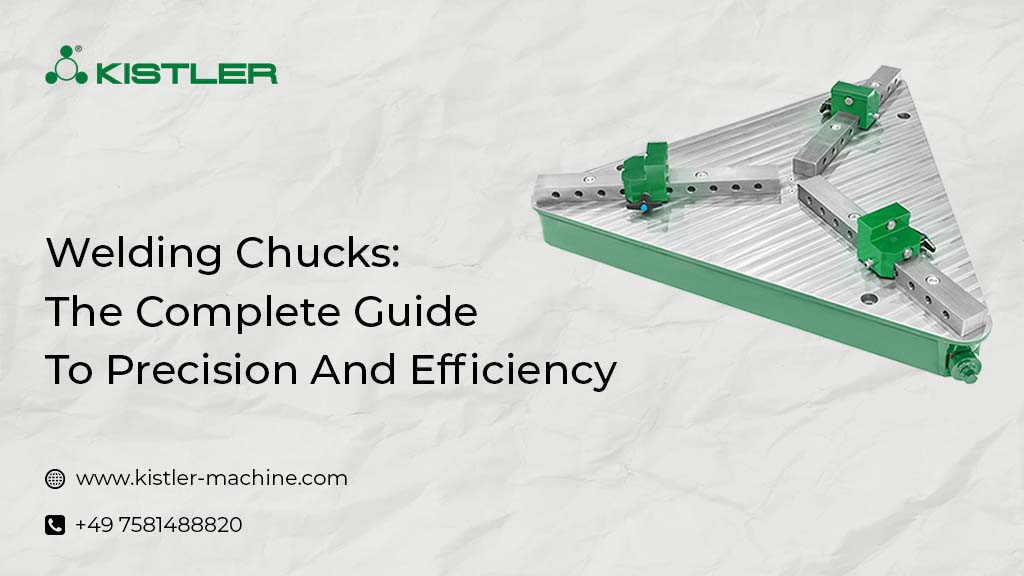
Welding is an art and a science that demands precision, and achieving that precision often depends on the tools and equipment used in the welding process.
Among these tools, welding chucks play a vital role in ensuring accuracy, efficiency, and safety. In this comprehensive guide, we will delve into the world of welding chucks, exploring their types, functions, advantages, and how they contribute to achieving high-quality welds.
Welding chucks, commonly referred to as chucks in the welding industry, are essential components used to hold workpieces securely in place during the welding process. They come in various forms and configurations, each designed for specific welding applications. The primary purpose of a welding chuck is to provide a stable and secure grip on the workpiece, preventing any unwanted movement or misalignment during welding.
1. Manual Welding Chucks
Manual welding chucks are among the most common types used in welding applications. They are operated manually by the welder and are known for their versatility and ease of use. These chucks feature adjustable jaws that can be tightened or released using a handwheel or lever mechanism. Manual welding chucks come in various sizes and designs to accommodate different workpiece shapes and sizes. They are widely used in industries such as automotive, construction, and fabrication.
2. Pneumatic Welding Chucks
Pneumatic welding chucks utilize air pressure to secure the workpiece. They offer faster clamping and release times compared to manual chucks, making them suitable for high-speed welding applications. Pneumatic chucks are known for their reliability and precision, making them a preferred choice in industries where consistent and repeatable results are essential.
3. Hydraulic Welding Chucks
Hydraulic welding chucks use hydraulic pressure to clamp the workpiece. They are prized for their exceptional clamping force and ability to hold large and heavy workpieces with ease. Hydraulic chucks are often used in heavy-duty welding applications, such as shipbuilding and aerospace, where the workpieces require a significant amount of force to be securely held in place.
Welding chucks offer several advantages that contribute to the efficiency and precision of the welding process:
1. Enhanced Precision
One of the primary benefits of using welding chucks is the ability to achieve precise and consistent welds. The secure grip provided by the chuck ensures that the workpiece remains in the correct position throughout the welding operation, minimizing the chances of misalignment or defects.
2. Increased Efficiency
Welding chucks streamline the setup process, reducing the time and effort required to position and secure the workpiece. This increased efficiency translates into higher productivity and cost savings for welding operations.
3. Improved Safety
By securely holding the workpiece, welding chucks enhance safety by reducing the risk of accidents caused by workpiece movement or slippage during welding. Welders can focus on the welding process itself without worrying about workpiece stability.
4. Versatility
Different types and sizes of welding chucks cater to a wide range of welding applications. Whether you are working on small, intricate parts or large, heavy components, there is a welding chuck designed to meet your needs.
Choosing the appropriate welding chuck for your application is crucial for achieving the desired results. Consider the following factors when selecting a welding chuck:
1. Workpiece Size and Shape
Determine the size and shape of the workpieces you will be welding. Choose a chuck that can accommodate the dimensions and geometry of your workpiece effectively.
2. Clamping Force
Evaluate the clamping force required for your welding process. Heavier or larger workpieces may necessitate chucks with higher clamping forces to ensure stability.
3. Welding Application
Consider the specific welding application, whether it's manual welding, robotic welding, or another type. Different applications may require different types of welding chucks.
4. Material Compatibility
Ensure that the chuck's materials are compatible with the materials you will be welding. Some materials may require specialized chucks to prevent contamination or damage.
5. Automation
If you are working with automated welding systems, select chucks that are compatible with automation equipment and can integrate seamlessly into your workflow.
Proper maintenance is essential to prolong the lifespan and
performance of your welding chucks Below are some maintenance guidelines to
take into account:
1. Regular Inspection
Inspect your chucks regularly for signs of wear, damage, or
misalignment. Take prompt action to resolve any issues and prevent further harm
or deterioration.
2. Lubrication
Apply lubrication to moving parts and components to ensure
smooth operation. Adhere to the lubrication type and schedule as advised by the
manufacturer.
3. Cleaning
Keep your chucks clean and free from debris, welding spatter, and contaminants that could affect their performance.
4. Calibration
Periodically calibrate your chucks to maintain their accuracy and clamping force. Consult the manufacturer's guidelines for calibration procedures.
Conclusion
Welding chucks, whether manual, pneumatic, or hydraulic, are
indispensable tools in the welding industry. They offer precision, efficiency,
and safety, contributing significantly to the quality of welds and the overall
productivity of welding operations. When selecting a welding chuck, carefully
assess your specific needs and requirements to ensure you choose the right tool
for the job. With the proper maintenance and care, welding chucks can serve as
valuable assets in achieving high-quality welds and successful welding
projects.
Kistler Cutting and Welding Techniques GmbH specializes in the production of high-quality welding chucks in various types.